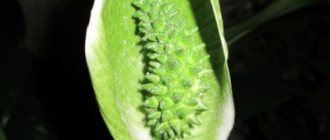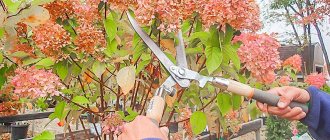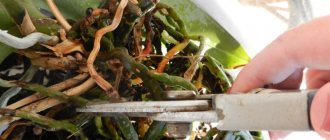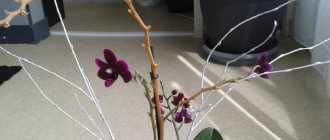The beautifully flowering plant spathiphyllum is very popular among flower lovers. He is credited with some magical properties, for which the fairer sex loves him so much. It is believed that spathiphyllum brings happiness, helps women in love and motherhood, for which it received the popular name “women’s happiness.”
The plant is unpretentious and does not require much effort when growing. It is important to know how to care for the bush during growth and flowering, as well as after the spathiphyllum fades. If the basic maintenance conditions are met, the flower will delight you for many years.
Briefly about spathiphyllum
The name "spathiphyllum" (or spathiphyllum) is derived from two Greek words: "spathe" - bedspread and "phyllon" - leaf. This is a perennial evergreen plant from the Araceae family.
The bush has no stem; its leaves grow directly from the soil. The roots are short, the leaves are long, oval or lanceolate in shape.
The inflorescence is on a peduncle, which is often confused with a stem. It consists of a cob and one petal-veil, which gave the name to the plant. The petal is white and quickly turns green after flowering.
There are about 40 species of spathiphyllum, many of them are grown at home.
If you are fond of flowers, but do not like capricious plants, the “feminine happiness” flower will suit you. What are the features of growing spathiphyllum?
Plant breeder
Spathiphyllum is a perennial plant that is valued for its beauty, beneficial properties and ease of care. The plant grows in damp, swampy areas. Distributed in Central and South America and the Asia-Pacific region. The flower is popularly called “female happiness.” Let's tell you more about it.
Photo: pixabay.com
Spraying is carried out 1-2 times a day.
It is advisable to place the flower pot on an eastern window, as diffused morning sunlight is ideal for a flower that loves bright lighting.
Little tips for gardeners:
- the room should be well lit, but avoid direct sunlight;
- the ideal temperature for the plant is +20-22 degrees;
- The flower should be watered with water that has stood for at least 24 hours at room temperature or with melt water;
- “female happiness” should be fed once or twice a month. Special fertilizers for spathiphyllum are diluted in a ratio of 1 gram per 1 liter of water.
Blooming or just faded spathiphyllum cannot be replanted, so as not to cause stress to an already weakened plant. This can only be done after a period of rest.
“Women's Happiness” does not require trimming leaves or shaping the crown. Remove or trim leaves as they age and dry out. You just need to cut off the peduncle, and we will explain in detail why later in our article.
Problems, diseases and pests of a flower
If not handled correctly, the houseplant weakens and allows pests to take up residence.
Here are the main types of pests that can spoil the decorative appearance of spathiphyllum, and in the absence of measures taken, completely ruin it:
The dimensions of the thrips insect are 1-2 mm. It can be recognized by the discoloration of first a few spots on the leaf, and then the loss of color completely. Thrips leave sticky traces and excrement both on the bottom of the leaf and on the upper surface. The pest is dangerous because of its speed of spread - it can jump from place to place and suck out the vital juices of the flower with its jaws.
Treatment - for watering you can use Aktar and Confidor (so-called systemic drugs)
But you can also use contact agents: Intavir, Karbofos, Fitoverm. They are bred according to the instructions and sprayed with flowers. A very radical method is also allowed - carefully turn the pot over and dip the spathiphyllum completely into the solution.
Slightly larger in size (2-3 mm) is another enemy of all indoor plants - aphids. Most often it is white or slightly greenish, although other shades are also found. This insect also sucks juices from spathiphyllum. Its danger lies in its very rapid reproduction. One female can produce 100,000 offspring in a month.
Means of control at the beginning of infection can be simpler, “folk” - infusions of garlic, pepper, celandine, citrus fruits, tobacco, but in the advanced stage it is no longer possible to do without chemicals.
Scale insects (and false scale insects) are pests that look like tiny turtles with transparent or brown shells. This insect settles on leaves, cuttings, and flowers. It is recommended to collect it using a soap solution on a rag or sponge. But stronger acaricides can also be used. For example, Aktara.
The closest relative of the scale insect is the mealybug. Its difference is that it is more selective in places of settlement on plants. Tender shoots, leaf axils - these are the parts of the plant where the laid eggs of a mealybug can suddenly appear in the form of fluffy white balls.
Control methods are the same as for scale insects.
Directly related to the presence of pests is a disease that the owner of spathiphyllum may encounter - sooty fungus. Aphids, scale insects and scale insects secrete and leave traces of their vital activity on the surface of the leaf - special substances on which this fungal infection settles.
A black coating like soot covers parts of the leaf, thereby closing the access of the stomata to air, moisture and light and further aggravating the malaise of the indoor flower.
The appearance of brown-brown spots means an excess of some chemical substance in the growing substrate.
Beginning of flowering
After the end of the dormant period, new leaves appear on the spathiphyllum, and a peduncle begins to develop in the petiole of one of them. It was this process that gave the plant its popular name: during the formation of the peduncle, the petiole thickens and becomes similar to the figure of a pregnant woman. The thickening increases in size, the green cover gradually moves apart, and the white cover of the future flower appears. After full ripening, the spathe bursts and an inflorescence appears.
Depending on the variety, the bush may produce one or more buds. Flowers continue to delight the owner from 1 month to six months.
Popular types (varieties)
Spathiphyllum profusely blooms - has the largest inflorescences and spathes up to 12 cm in length and up to 6-8 in width.
Spathiphyllum chopin - has compactness (up to 35 cm in height) and the beauty of glossy leaves. The flowers are white or greenish. A surprisingly subtle and pleasant aroma comes from the flowers of this variety in the morning. Spathiphyllum Chopin is perhaps the most common variety on our windowsills.
If you find a red spathiphyllum , keep in mind that it is no longer a spathiphyllum, but an anthurium - a plant close to spathiphyllum, but still completely different. So, in fact, red spathiphyllum
Spathiphyllum cupido is interesting due to the special shape of its flower leaf-veil. It has greenish splashes and a gracefully elongated shape.
Spathiphyllum Domino has interesting leaf colors. They seem to be dressed up in a Domino costume, since green spots alternate with white spots and stripes.
Spathiphyllum alana is the largest: about half a meter in height. This species is beautiful because of its tube-shaped bedspreads that do not unfold completely.
Spathiphyllum mix is a combination of several varieties of spathiphyllum in one pot.
Conditions for long flowering
All varieties of spathiphyllum bloom. If flowering does not occur during the year, then you should think about the conditions of maintenance and care.
First of all, a diseased plant will not bloom. A flower with dry leaf tips definitely requires more frequent watering and spraying. Or perhaps he is standing in a draft. Also check the temperature in the room, move the bush away from radiators so that it is not too hot and dry. If the tips of the leaves are curled, then most likely the plant is freezing. Soft yellowed leaves indicate excess moisture, dry yellow leaves indicate insufficient watering or hard water.
If the flower is visually healthy and has green, elastic leaves, then you should pay attention to proper care. Correcting possible errors contributes to long and abundant flowering:
- water for irrigation should be soft and free of impurities. Use tap water that has stood for at least 24 hours in the summer, and melt water at room temperature in the winter;
- choose a suitable pot. In a container that is too large, the flower devotes all its energy to the formation of roots rather than inflorescences;
- place the spathiphyllum in a cooler place, reduce watering, and then return it to its usual conditions. After temporary dormancy, the plant often produces flower stalks;
- Feed the bush once every two weeks, alternating organic and mineral fertilizers or using combined fertilizers for spathiphyllums.
After the inflorescences appear, the plant should be watered and sprayed more abundantly. On normal days, it is advisable to spray once a day, on hot days - twice.
Replanting the plant during flowering is strictly prohibited. It can not only lose flowers, but also die. During this period, spathiphyllum spends a lot of energy on the formation of buds, and replanting greatly weakens it.
Fading inflorescences must be removed. How and why to prune faded flowers of spathiphyllum will be discussed in detail below.
Magic rituals
Money rituals
Golden coins lying under the pot will attract financial well-being. To get out of debt or improve your financial situation, you should move the flower closer to the place where your savings are. You should also put a coin under the spathiphyllum; the denomination can be any, but the color must be golden. A healthy leaf is tied with a light green ribbon, onto which a decorative or elegant key that has not been used for a long time is attached. The desired result is mentally spoken out with clear visualization. When the flowers open, the light green ribbon changes to scarlet. The key is also outweighed. 1-2 weeks after the magical ritual, the owner of the spathiphyllum will advance up the career ladder, receive a bonus, or gain a rich admirer.
A quick way to get money soon is to bury banknotes in the ground under a flower. Better - currency.
Love magic
To meet a reliable partner, you need to pick 1 flower in a good mood. An apology is immediately made. Then you need to go up to a wide wall mirror without clothes and, looking in the reflection, trace the contours of the body with a twig. Feeling the warmth flaring up in the area of the pile, you should visualize the image of the desired man. Having circled the chest with spathiphyllum and frozen under the left one, he says out loud: “I feel love, I believe in it.” Concentration of attention switches to the tummy with the reservation: “I’m expecting love, I’m thirsty.” The palm extends forward to the reflection and says: “Behind me (name) is real, sincere love. Forward - she too. Left and right, above your head and under your feet - love is everywhere. Feelings are calling me, they are calling you, they will bring you here. I will love and they will love me. Let it be so!". The ritual is repeated the next day to consolidate the result.
Another work ritual takes place after midnight, when Friday arrives. The month is definitely growing. Only a practitioner should be in the apartment. You should take the flower in your hands, go out to the window, and, fixing your gaze on the month, inhale the smell of spathiphyllum with your nose. They turn to the creator of the magical plant, Astarte, for help. You need to ask the goddess 3 times to bring the desired man, and the more detailed the description of both internal and external qualities, the greater the power of the ritual. Then a scarlet candle is lit near the spathiphyllum. The wick should be lit every night until the full moon appears.
Caring for the plant after flowering
If the spathiphyllum has faded, how to care for it further, what to do with the peduncles and leaves, can it be replanted?
After flowering, you should cut off the spathiphyllum peduncles and give it a period of rest. Caring for the plant at this time is as follows.
- reduce watering;
- feed no more than once a month;
- do not leave the plant at temperatures below 15 degrees.
Some varieties of “female happiness” can bloom all year round, so you don’t need to change their care. But the amount of fertilizing should still be reduced.
If the plant is already dormant, the petal has fallen off on its own, and the peduncle has dried out, you should not prune faded spathiphyllum flowers. Just carefully unscrew the arrow from the ground, being careful not to harm the roots.
Perhaps you are wondering whether and how to prune spathiphyllum that has faded?
What to do if the tips of spathiphyllum leaves turn black due to large doses of fertilizer?
Indoor plants require almost four times less fertilizer than those grown in greenhouses, especially using hydroponic systems.
Before sale, greenhouse plants are planted in transport pots, adding a special complex of long-acting fertilizers under the roots. Such substances, with regular watering, can ensure the preservation of the bush for up to 4–6 weeks.
And then the owner of the flower needs to fertilize it himself. And here you cannot overdo it, otherwise an excessive amount of fertilizer will become the reason why the leaves of the spathiphyllum turn black, which just yesterday delighted with a healthy gloss and rich color. In addition, spathiphyllum reacts by slowing growth and necrosis not only on the leaf blades, but also on parts of the root system. Moreover, mature leaves respond more sharply to excess nutrition.
Does spathiphyllum need pruning?
It was previously discussed whether spathiphyllum leaves need to be trimmed. The bush has an extensive root system, and each leaf lives almost separately. Therefore, pruning of spathiphyllum leaves is not required. The exception is old, withered leaves, as well as yellowed tips of the leaves of a diseased plant. Another question is whether pruning the spathiphyllum peduncle is necessary.
After flowering, “female happiness” loses a lot of strength, the already unnecessary peduncle takes away the remaining ones. Therefore it needs to be cut off. In addition, a faded flower looks unaesthetic and spoils the appearance of an ornamental plant. In addition, pruning stimulates the growth of new shoots.
How to prune spathiphyllum correctly? It is better to do this with sharp scissors or a stationery knife. The entire arrow should be cut off, as close to the base as possible.
If the peduncle has completely dried out on its own, it should be carefully unscrewed from the rosette of leaves.
Important! Spathiphyllum is considered a poisonous plant; if it comes into contact with the skin and mucous membranes, its juice can cause irritation or an allergic reaction. If you prune the plant, it is better to use gloves.
Is it harmful?
In addition, the upper respiratory tract becomes inflamed, which leads to difficulty breathing. People who are prone to allergies may develop skin rashes and other allergic disorders.
ATTENTION: If spathiphyllum was accidentally ingested by a child, then immediately show it to a doctor, as the consequences can be very unpredictable.
Spathiphyllum contains poisonous juice. It can cause swelling of the larynx in pets, and if it gets into the eyes, irreversible changes in the corneal tissue will begin to develop. If a cat or dog eats part of the leaf, the tongue, mouth and throat will begin to burn. Then blisters form. The animal must be taken to the veterinarian immediately, as you may lose your pet.
Answers to readers' questions
Plant lifespan
Each specimen of spathiphyllum can live about 10 years. But during this time, you can (and should) separate several new plants from it, which will also serve your home for many years.
Is it possible to keep this plant at home?
It is generally accepted that spathiphyllum ennobles the atmosphere of the place where it grows. Purifies the air and saturates it with oxygen. And, of course, it pleases the eye with the beauty of the leaves and the delicacy of the flowers, which is why spathiphyllum is very common among house flowers.
Is this flower poisonous?
All plants of the Aroniaceae family are endowed with very poisonous sap. By simply touching or rubbing the leaves, no intoxication can occur, but it is better to carry out work on transplanting, pruning and propagating spathiphyllum while wearing gloves. Do not allow irritating substances to get into your eyes, and also take care of children and pets.











